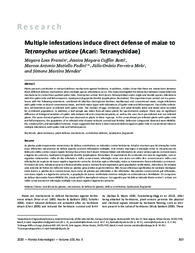Multiple infestations induce direct defense of maize to Tetranychus urticae (Acari: Tetranychidae).
Multiple infestations induce direct defense of maize to Tetranychus urticae (Acari: Tetranychidae).
Author(s): FRANZIN, M. L.; BOTT, J. M. C.; FADINI, M. A. M.; MELO, J. O. F.; MENDES, S. M.
Summary: Plants present constitutive or induced defense mechanisms against herbivory. In addition, studies show that there are interactions between these different defense mechanisms when multiple species infestations occur. This study investigated the interaction between maize defensive mechanisms to control two-spotted spider mite, Tetranychus urticae Koch (Acari: Tetranychidae) under single and double species infestations with this spider mite and fall armyworm, Spodoptera frugiperda (Smith) (Lepidoptera: Noctuidae). The experiment was carried out in a greenhouse with the following treatments: uninfested Bt (Bacillus thuringiensis Berliner; Bacillaceae) and conventional maize, single infestation with spider mite on Bt and conventional maize, and both maize types with infestations of spider mite and fall armyworm. Two d after infestation, all treatments were re-infested with spider mite. The number of eggs, immatures, and adult females (alive and dead) were recorded for re-infested populations. In addition, a leaf sample was taken from all maize plants for spectrometric analysis. There was no significant difference of biological variables of spider mite between Bt and conventional plants, as well as the ones from pre-infested and non-infested plants. The same chemical pattern of ions was observed on plants in these 4 groups. In the conventional pre-infested plants with spider mite and fall armyworm, the population of re-infested mite showed reduced survival and fertility. Defensive compounds detected were HMBOAGlc, Linoleoyl-GPI, and kaempferol rutinose. It was suggested that there is direct induced defense against spider mite in conventional maize in multiple infestations with spider mite and fall armyworm.
Publication year: 2020
Types of publication: Journal article
Unit: Embrapa Maize & Sorghum
Observation
Some of Embrapa's publications are published as ePub files. To read them, use or download one of the following free software options to your computer or mobile device. Android: Google Play Books; IOS: iBooks; Windows and Linux: Calibre.
Access other publications
Access the Agricultural Research Database (BDPA) to consult Embrapa's full library collection and records.
Visit Embrapa Bookstore to purchase books and other publications sold by Embrapa.

